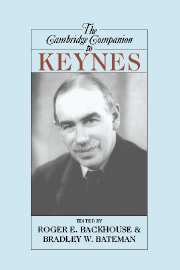Book contents
- Frontmatter
- 1 A cunning purchase: the life and work of Maynard Keynes
- 2 The Keynesian revolution
- 3 Keynes and the birth of modern macroeconomics
- 4 Keynes as a Marshallian
- 5 Doctor Keynes: economic theory in a diagnostic science
- 6 Keynes and British economic policy
- 7 Keynes and Cambridge
- 8 Keynes and his correspondence
- 9 Keynes and philosophers
- 10 Keynes’s political philosophy
- 11 Keynes and probability
- 12 The art of an ethical life: Keynes and Bloomsbury
- 13 Keynes and ethics
- 14 Keynes between modernism and post-modernism
- 15 Keynes and Keynesianism
- Bibliography
- Index
6 - Keynes and British economic policy
Published online by Cambridge University Press: 28 November 2006
- Frontmatter
- 1 A cunning purchase: the life and work of Maynard Keynes
- 2 The Keynesian revolution
- 3 Keynes and the birth of modern macroeconomics
- 4 Keynes as a Marshallian
- 5 Doctor Keynes: economic theory in a diagnostic science
- 6 Keynes and British economic policy
- 7 Keynes and Cambridge
- 8 Keynes and his correspondence
- 9 Keynes and philosophers
- 10 Keynes’s political philosophy
- 11 Keynes and probability
- 12 The art of an ethical life: Keynes and Bloomsbury
- 13 Keynes and ethics
- 14 Keynes between modernism and post-modernism
- 15 Keynes and Keynesianism
- Bibliography
- Index
Summary
INTRODUCTION
Keynes's impact on economic policy has been the subject of widely contrasting interpretations. Most economists in the 1950s and 1960s, when unemployment rates of between 1 and 2 per cent came to be regarded as normal, credited Keynes (and their own profession) with providing the cure to the high unemployment that had marked the interwar years. Keynes's General Theory of Employment, Interest and Money (1936) was developed and refined by his followers - known as Keynesians - to guide governments in how to achieve the goals of full employment, stable prices and a sound external balance of payments (and thereby a stable, but adjustable, exchange rate). Keynesian economists believed that fiscal policy (variations in the levels of taxation and of government expenditure) was more effective than domestic monetary policy (variations in interest rates and in banks' reserves) in influencing demand for goods and services, as regards increasing employment. In the event, it was not difficult to maintain full employment during the long postwar boom.
- Type
- Chapter
- Information
- The Cambridge Companion to Keynes , pp. 98 - 117Publisher: Cambridge University PressPrint publication year: 2006
- 5
- Cited by

